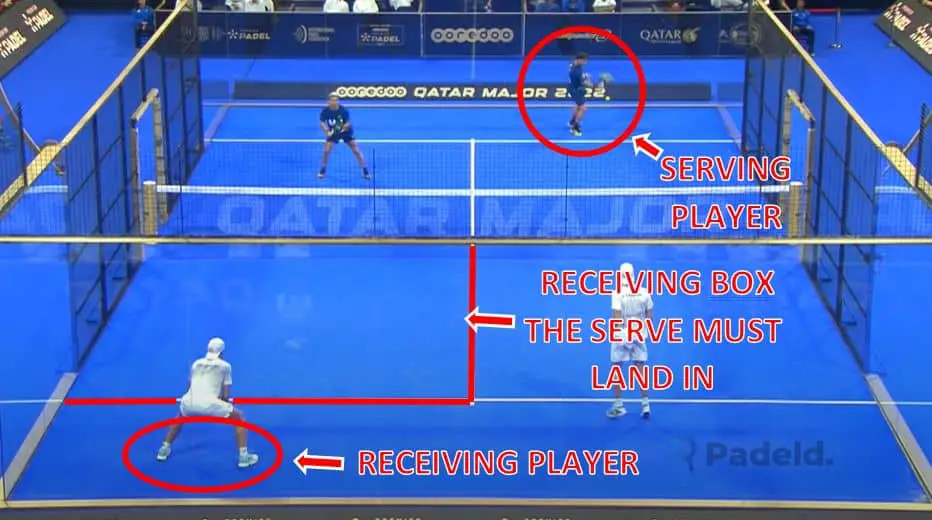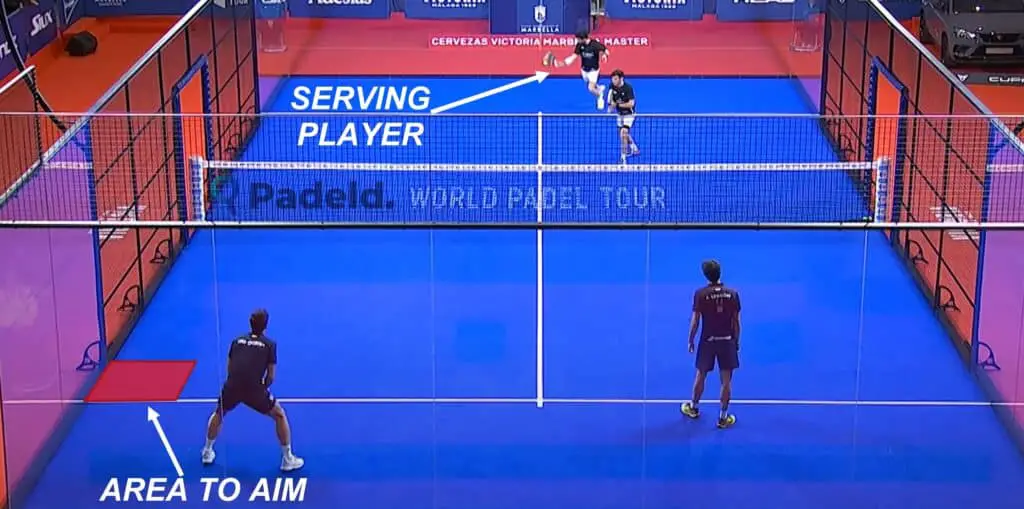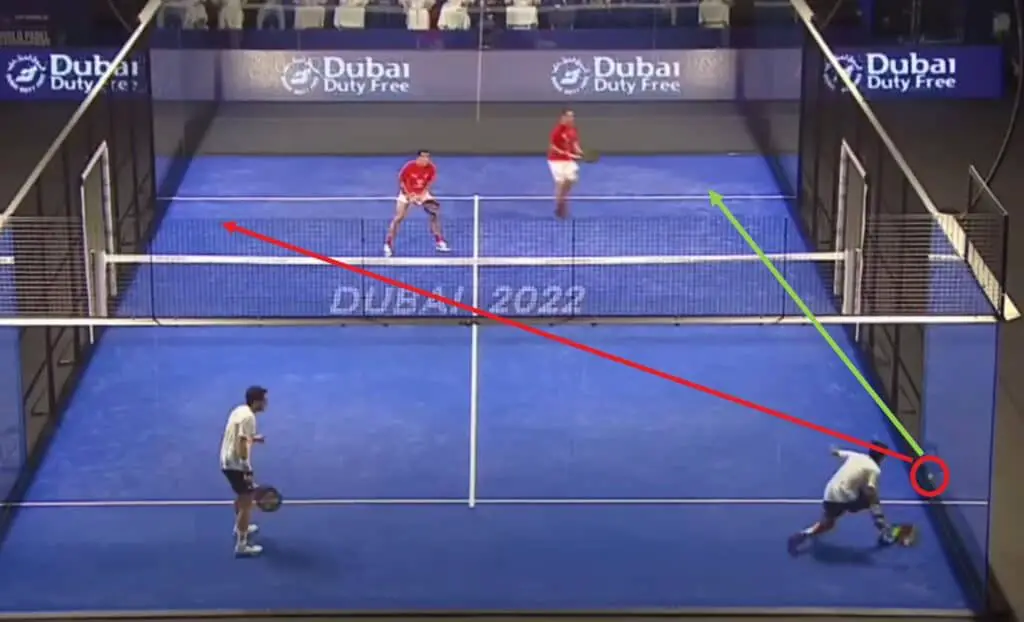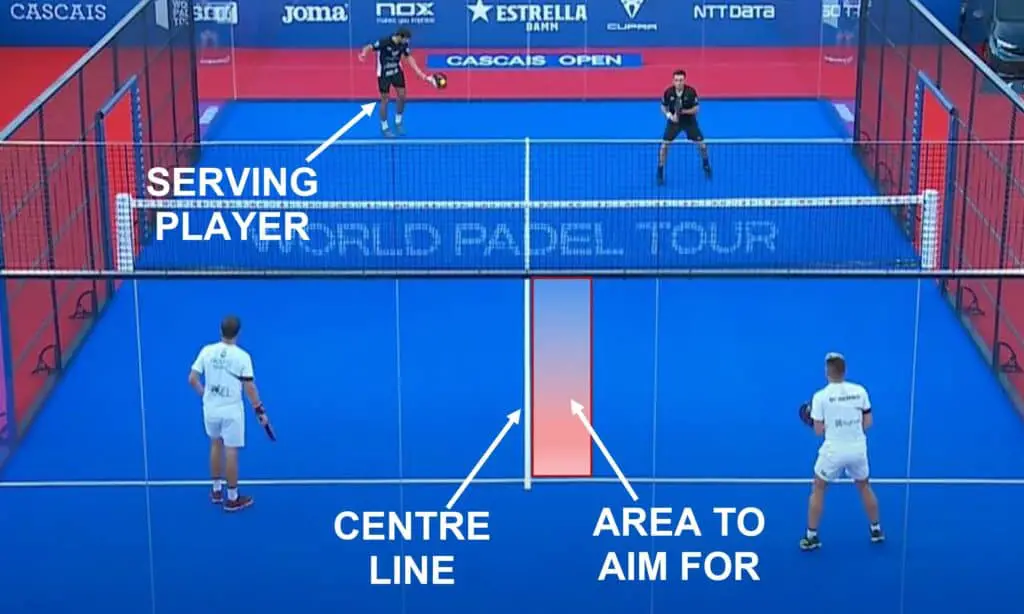Compared to a lot of other racket sports, the technique required to hit a serve in padel is pretty simple. However, the technical side of the serve isn’t the only important part! There’s also the strategic part of the serve – which basically refers to where you’re allowed to land the ball, and the sorts of areas you should be targeting against different types of players. If you can improve this part of your play, you will become a much tougher player to play against and will be able to get your team in much better positions when you’re serving.
In this post I’ll be sharing all of the rules you need to know about where your serve is allowed to land. The quicker you learn this the better – as it will help you avoid a lot of unnecessary faults and points being awarded to your opponents. As well as the rules regarding where you should be serving, I’ll also give you an insight into the tactical element of the game and share some thoughts about why you may choose to target different areas of the court when its your turn to serve. Let’s get into it!
So, where can you serve in padel?
A padel serve must pass over the net and land inside the opponent’s ‘receiving box’. The serve can land anywhere in the receiving box, as long as it doesn’t hit the metal fence before the second bounce. Therefore, the serving player has several tactical options as to exactly where they can land the ball in the box.

The diagram above should make this a bit easier to visualise! In padel, the receiving box that you have to aim for will always be diagonally opposite the serving player. The ball’s first bounce off a surface must occur inside the box, so this means you can’t serve the ball into one of the walls and then hope it bounces into the receiving box. It’s also worth noting that if you serve the ball and it hits the line that surrounds the receiving box, this counts as in!
If the serving player fails to land the ball in the receiving box, their serve will be counted as a ‘fault’, meaning that they will have to attempt their serve again. If they fail to land the ball in the receiving box on their second attempt, then this will be called as a ‘double fault’ and the serving team will lose the point. In padel there are many ways that you can serve a fault – it doesn’t just happen when you fail to land the ball in the receiving box! I’ve written a post which details all of the different ways that faults occur, and if you’re interested in that you can read it by clicking here!
When serving, there are broadly 3 different areas within the receiving box that you can target. Each area has advantages and disadvantages, so players should try to make use of them all from time to time. Let’s explore them in more detail below!
Serving Towards The Glass Wall
One of the main areas you can serve is towards the outer edge of the receiving box where it meets the glass wall. This is probably the most effective place to serve in terms of how challenging it will be for your opponent to return the ball, but it’s also one of the toughest serves for you to get right. It requires a lot of accuracy!

So, why does it require a lot of accuracy? There are two main reasons for this:
- The ball could hit the wall before the ground – If you’re serving the ball towards the wall on the far side of the court, there is always a risk that you could hit the ball slightly too hard, causing it to make contact with the wall before it hits the floor. If this happens, this is classed as a fault and you will have to attempt a second serve. The ball must bounce on the ground first before hitting the wall.
- The ball could hit the fence after bouncing – If you land the ball on the ground inside the receiving box but the direction of your serve was slightly poor, the ball could bounce and go on to hit the metal fence around the side of the court. This would count as a fault! If you’re serving towards the wall at the far side of the court, the ball must hit the glass part of the wall after it bounces! This can be harder than it sounds, as you don’t have a huge target to aim at. The wall at the side of the receiving box is 7 metres long, but only 1 metre of this wall is made from glass! You can see this in my diagram below. The other 6 metres of the wall next to the receiving box are the metal fence, so you’ll need to avoid bouncing the ball into this larger area in order to hit a valid serve.

If you can avoid the two things I mentioned above and hit good reliable serves that bounce in the receiving box before going on to hit the glass part of the wall, you will cause problems for your opponent. But why is this? These serves are tougher for players to respond to because they give the receiving player one extra bounce to react to, and this is a bounce that occurs when the ball is very close to them.
To explain what I mean, imagine a serve that is hit straight towards the receiving player. Against this type of serve, they can track the flight of the ball all the way from the moment it leaves your racket until it reaches them. The ball will not suddenly change direction during it’s flight, so they can quickly position themselves in a way that will allow them to hit the ball and can mentally prepare the shot they are going to play. However, when the ball is served towards the wall, they cannot be sure what shot they are going to play as there will be an element of uncertainty with regards to how the ball will rebound from the wall. Therefore, they are less prepared to play their shot and will have less time to react and hit the ball.
This type of serve also puts limits on the types of shots that your opponent can play in return, which can give you an advantage! This is because the ball is probably going to be very close to the glass wall when your opponent hits their return, which makes it harder for them to hit their return diagonally cross-court. Instead, they are much more likely to hit shots that stay close to the wall. This is illustrated by my diagram below!

I’d also recommend using this serve in a scenario where your opponent has positioned themselves too close to the centre of the court. If they’re in this position, they’re a long way away from the glass wall and this may mean that a quickly hit serve in that direction may cause them a lot of problems! Additionally, it’s always worth monitoring whether the receiving player is better hitting the ball with their forehand or their backhand. If you’re serving to a player and it’s clear that hitting the ball towards the glass wall would force your opponent to hit the ball with their weaker stroke, then this is an option you should take. You should try to serve the ball away from your opponent’s strength as often as possible!
Serving Towards The Centre Line
Hitting your serve towards the centre line of the court is another great option that you should consider using during certain game situations. This is another type of serve that has a relatively small margin for error but can be very effective if you get it right! If you’re not sure where the centre line is, take a look at the picture below! As I just mentioned, this is a tough serve to get right because we want to get the ball as close to the centre line as possible without hitting a fault. If the ball hits the centre line this counts as in, but if you stray over the line into the wrong receiving box, that would be a fault.

I would recommend using this serve in a few scenarios, the first of which is when your opponent has positioned themselves too close to the wall of the court. Because the serve towards the wall can be slightly challenging to deal with, a lot of receiving players will edge themselves over towards the wall so that they can be in a better position to deal with it. This position takes them further away from the centre line, so a surprise serve in this direction could catch them off guard. Also, you should use the centre line serve if it would force your opponent to play their weaker stroke out of the backhand/forehand. One of my friends who I’ve played padel with many times has a very dodgy backhand, so I will constantly try to hit serves that target this weakness!
Serving Down The Middle Of The Receiving Box
The serve down the middle of the receiving box is the easiest one to hit as it doesn’t require a great deal of accuracy. If you hit the serve slightly too far to the left or the right there is still a good chance that it will land in the receiving box – all you really have to worry about is the depth of the serve and making sure you get just the right amount of power on the shot.
I would recommend that all inexperienced padel players start by using this serve. As I just mentioned, it’s probably the easiest one to get right and will lead to you hitting the least number of faults while you improve your accuracy.
Conclusion
I hope that this post has given you a good overview of the rules regarding where you’re allowed to serve, as well as giving you some ideas for different serves you can use in certain situations. In addition to being a physical game, padel is a very tactical game, and as such we should always be looking for errors in our opponent’s position or weaknesses in their game that we can take advantage of when serving. If you liked this content and want to see more, feel free to keep an eye on the site for my upcoming posts! Additionally, why not check out some others that I’ve already written? I hope you enjoy!
